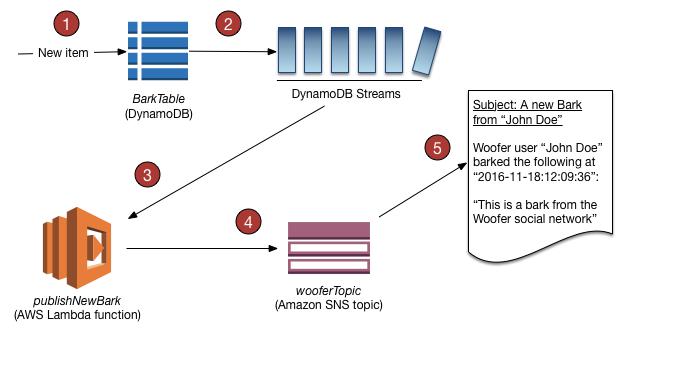- All Exams Instant Download
Which of the following is the most suitable solution that you should implement to meet the requirement?
A popular social network is hosted in AWS and is using a DynamoDB table as its database. There is a requirement to implement a ‘follow’ feature where users can subscribe to certain updates made by a particular user and be notified via email .
Which of the following is the most suitable solution that you should implement to meet the requirement?
A . Create a Lambda function that uses DynamoDB Streams Kinesis Adapter which will fetch data from the DynamoDB Streams endpoint. Set up an SNS Topic that will notify the subscribers via email when there is an update made by a particular user.
B . Using the Kinesis Client Library (KCL), write an application that leverages on DynamoDB Streams Kinesis Adapter that will fetch data from the DynamoDB Streams endpoint. When there are updates made by a particular user, notify the subscribers via email using SN
D . Set up a DAX cluster to access the source DynamoDB table. Create a new DynamoDB trigger and a Lambda function. For every update made in the user data, the trigger will send data to the Lambda function which will then notify the subscribers via email using SN
F . Enable DynamoDB Stream and create an AWS Lambda trigger, as well as the IAM role which contains all of the permissions that the Lambda function will need at runtime. The data from the stream record will be processed by the Lambda function which will then publish a message to SNS Topic that
will notify the subscribers via email.
Answer: D
Explanation:
A DynamoDB stream is an ordered flow of information about changes to items in an Amazon DynamoDB table. When you enable a stream on a table, DynamoDB captures information about every modification to data items in the table.
Whenever an application creates, updates, or deletes items in the table, DynamoDB Streams writes a stream record with the primary key attribute(s) of the items that were modified. A stream record contains information about a data modification to a single item in a DynamoDB table. You can configure the stream so that the stream records capture additional information, such as the "before" and "after" images of modified items.
Amazon DynamoDB is integrated with AWS Lambda so that you can create triggers―pieces of code that automatically respond to events in DynamoDB Streams. With triggers, you can build applications that react to data modifications in DynamoDB tables.
If you enable DynamoDB Streams on a table, you can associate the stream ARN with a Lambda function that you write. Immediately after an item in the table is modified, a new record appears in the table’s stream. AWS Lambda polls the stream and invokes your Lambda function synchronously when it detects new stream records. The Lambda function can perform any actions you specify, such as sending a notification or initiating a workflow.
Hence, the correct answer in this scenario is the option that says: Enable DynamoDB Stream and create
an AWS Lambda trigger, as well as the IAM role which contains all of the permissions that the Lambda function will need at runtime. The data from the stream record will be processed by the Lambda function which will then publish a message to SNS Topic that will notify the subscribers via email.

The option that says: Using the Kinesis Client Library (KCL), write an application that leverages on DynamoDB Streams Kinesis Adapter that will fetch data from the DynamoDB Streams endpoint. When there are updates made by a particular user, notify the subscribers via email using SNS is incorrect. Although this is a valid solution, it is missing a vital step which is to enable DynamoDB Streams. With the DynamoDB Streams Kinesis Adapter in place, you can begin developing applications via the KCL interface, with the API calls seamlessly directed at the DynamoDB Streams endpoint. Remember that the DynamoDB Stream feature is not enabled by default.
The option that says: Create a Lambda function that uses DynamoDB Streams Kinesis Adapter which will fetch data from the DynamoDB Streams endpoint. Set up an SNS Topic that will notify the subscribers via email when there is an update made by a particular user is incorrect because just like in the above, you have to manually enable DynamoDB Streams first before you can use its endpoint.
The option that says: Set up a DAX cluster to access the source DynamoDB table. Create a new DynamoDB trigger and a Lambda function. For every update made in the user data, the trigger will send data to the Lambda function which will then notify the subscribers via email using SNS is incorrect because the DynamoDB Accelerator (DAX) feature is primarily used to significantly improve the in-memory read performance of your database, and not to capture the time-ordered sequence of item-level modifications. You should use DynamoDB Streams in this scenario instead. References:
https://docs.aws.amazon.com/amazondynamodb/latest/developerguide/Streams.html
https://docs.aws.amazon.com/amazondynamodb/latest/developerguide/Streams.Lambda.Tutorial.html
Check out this Amazon DynamoDB Cheat Sheet:
https://tutorialsdojo.com/amazon-dynamodb/
Latest SAA-C03 Dumps Valid Version with 400 Q&As
Latest And Valid Q&A | Instant Download | Once Fail, Full Refund
Subscribe
Login
0 Comments
Inline Feedbacks
View all comments

